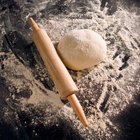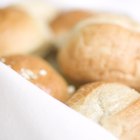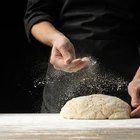
Homemade yeast rolls put the finishing touch on dinner. But, between helping kids with their homework, working and making the rest of the meal, you might not have time to prepare the dough. Most recipes for yeast rolls call for two rises, the first of which takes about 90 minutes. You can get a jump on making homemade rolls by starting the dough the night before and placing it in the refrigerator overnight.
Storing the Dough
If you are going to refrigerate the dough the night before baking, you can either chill it before or after you shape the rolls. You do not need to let the dough rise before you refrigerate it if you are chilling unshaped dough. The dough will continue to rise in the refrigerator. The process of rising takes longer, but it also allows the dough to develop more flavor. If you refrigerate it after shaping, let the rolls rest at room temperature for half an hour before placing them in the refrigerator. Cover the dough tightly with plastic wrap to keep it from drying out.
After You Refrigerate
You have to be somewhat attentive to the dough for the first few hours after you refrigerate it. Chilling the dough slows down the yeast. But, it takes a few hours for the yeast to cool enough to become dormant. For the first three hours, check on the unshaped dough every hour. Punch it down to keep it from over-proofing during that time. You don't have to punch down rolls that you've already shaped.
The Next Day
Take the dough out of the refrigerator about an hour before you plan on baking the rolls. If you try to shape the dough into rolls when it is still cold, the resulting rolls will have a strange texture, according to Rose Levy Berenbaum, author of "The Bread Bible." Let the dough rest at room temperature for 30 minutes to one hour. If the dough is already shaped, let it rest at room temperature until an indentation remains when you press a finger into it.
Freezing Dough
You can also freeze the dough for yeast rolls in advance, though both Berenbaum and the makers of Red Star Yeast don't recommend doing so. Berenbaum believes that freezing dough leads to a loss of flavor, as the yeast are upset by the freezing process. If you choose to freeze the dough to bake later, add up to 25 percent more yeast to the recipe to make up for any that might be damaged or killed after freezing. When thawing the dough, place it in the refrigerator overnight.
Related Articles
Can You Refrigerate Homemade Yeast ...

How to Preserve Dough That Has Risen

Can Yeast Bread Dough Be Frozen Before ...

What Happens if the Yeast Dies Before ...

What to Do With Pizza Dough When You're ...

Can I Make Monkey Bread the Night ...

How to Make Bread With Ancient Grains

Can Crescent Rolls Expire?
How to Make Bread That Does Not Crumble ...

Can I Make Chapati Dough in Advance?

Can I Make Doughnuts From Frozen Yeast ...

Do You Have to Allow Pizza Dough to ...

How to Freeze Brioche

Can You Make Croissants With Baking ...
How to Keep Crusty Italian Bread Soft

Why Does Bread Drop in the Middle When ...
Secret to Making Soft Chewy Italian ...

How to Increase the Yeast Taste in Bread

How to Make a Bread Starter

How to Bake With Besan Flour
References
Writer Bio
Based in Pennsylvania, Emily Weller has been writing professionally since 2007, when she began writing theater reviews Off-Off Broadway productions. Since then, she has written for TheNest, ModernMom and Rhode Island Home and Design magazine, among others. Weller attended CUNY/Brooklyn college and Temple University.
Photo Credits
Jupiterimages/Photos.com/Getty Images